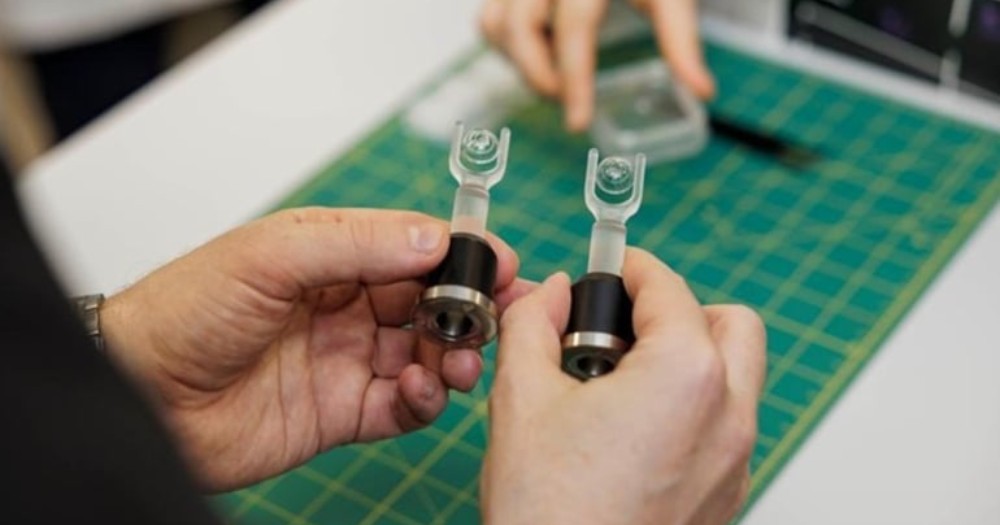XPANCEO showcases five smart contact lens prototypes

At the AWE Asia conference, deep-tech startup XPANCEO showcased five advanced prototypes that highlight the potential of smart lenses to transform how we see the world and how we manage our health and security.
With the goal of releasing a fully functional prototype by 2026, XPANCEO is paving the way for new possibilities in personal health monitoring and augmented reality.
How does it work?
One of the most promising prototypes presented by XPANCEO is the smart contact lens with nanoparticles for color correction, aimed at improving the quality of life for individuals with color blindness. By embedding nanoparticles-extremely tiny structures a million times thinner than a human hair-into the lens, the material can be engineered to interact with light in a unique way. This manipulation of the light spectrum enhances contrast and allows people with color blindness to see a broader range of colors. Unlike conventional glasses, these lenses offer a lightweight, unobtrusive solution, providing comfort and ease for the 350 million people worldwide who are affected by color blindness.
In addition to aiding color perception, XPANCEO has developed a smart contact lens with a unique optical pattern for verification, which can be used for secure identification. This lens features an optical pattern that changes depending on the angle and distance of the viewer, making it incredibly difficult to replicate. This innovation allows for secure transactions, such as payments or fund transfers, and controlled access to restricted areas, without the need for cumbersome security protocols.
The company also showcased significant advancements in health-focused prototypes. These include a smart contact lens equipped with an intraocular pressure (IOP) sensor for glaucoma detection. This sensor, tested on a custom eye model, provides a 50% improvement in effectiveness over current solutions, offering a critical tool for early detection of glaucoma, which is a leading cause of blindness. The ability to monitor eye pressure continuously and non-invasively represents a significant leap forward in managing eye health.
Why does it matter?
The health implications of XPANCEO's smart contact lenses are far-reaching. For those at risk of glaucoma, a condition that can lead to irreversible blindness if left untreated, the intraocular pressure sensor embedded in the lens provides a more accessible and effective way to monitor eye health. Traditional methods for checking eye pressure are often cumbersome and infrequent, leaving room for deterioration between check-ups. With XPANCEO's technology, real-time monitoring becomes possible, allowing for earlier intervention and potentially saving sight.
Furthermore, the nanoparticles used in the color-correcting lens could offer a discreet solution for people with color blindness, removing the need for external devices or specialized glasses. This enhancement in vision can improve daily activities as well as safety, by allowing those affected to perceive critical color-coded information, such as traffic signals or hazard warnings.
The application of smart lenses in augmented reality and verification processes also has potential health benefits. For example, the lenses could be used to guide visually impaired individuals through unfamiliar environments or provide real-time health data to healthcare providers, enhancing both personal safety and quality of care.
The context
XPANCEO is expanding the horizon of wearable technology by considering its applications beyond Earth, particularly in space exploration. The company's smart lenses could address the unique challenges faced by astronauts, who often deal with limited mobility and the need to operate complex equipment in zero-gravity conditions. Currently, astronauts are known to use their noses to navigate tablets and rely on verbal instructions, which can be inefficient and error-prone. With 80% of astronauts already wearing contact lenses, the integration of smart technology is a natural progression.
XPANCEO's lenses could overlay visual instructions directly onto an astronaut's field of view, simplifying tasks and reducing mistakes. Additionally, the lenses can continuously monitor vital health metrics, such as intraocular pressure, which is crucial in the harsh environment of space. By developing smart lenses that support both visual guidance and health monitoring, XPANCEO aims to make space missions safer and more efficient, proving that the potential applications of these technologies are truly limitless.
💡Did you know?
You can take your DHArab experience to the next level with our Premium Membership.👉 Click here to learn more
🛠️Featured tool
 Easy-Peasy
Easy-Peasy
An all-in-one AI tool offering the ability to build no-code AI Bots, create articles & social media posts, convert text into natural speech in 40+ languages, create and edit images, generate videos, and more.
👉 Click here to learn more


